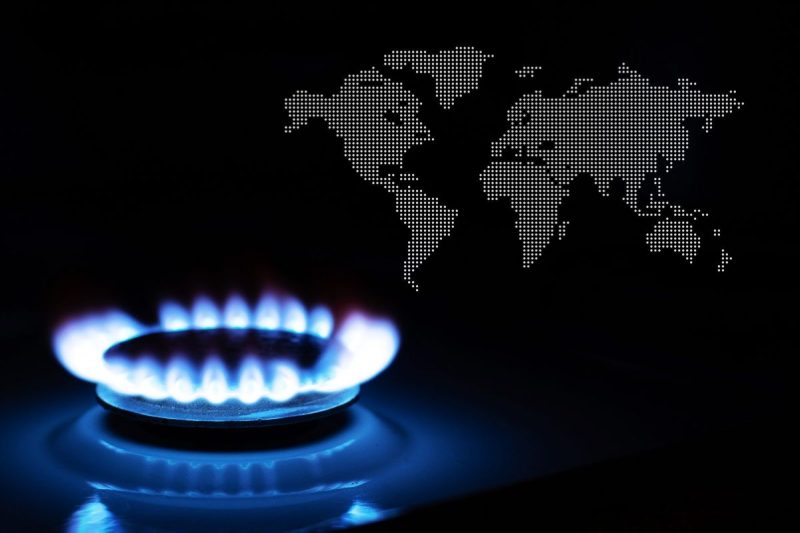Natural gas is an important energy fuel, even as the world transitions to a carbon-free economy. When investing in this industry, it’s key to know the ins and outs of natural gas production by country.
Global natural gas production remained fairly stable in 2022 at 4.09 trillion cubic meters, according to data from Statista. However, Russia’s natural gas production fell by 12 percent during the period on lower exports to Europe.
Although the country is still the world’s second largest natural gas producer and the second largest exporter of the fuel, the EU is looking to phase out Russia-sourced natural gas by 2027 due to the country’s war with Ukraine. The EU reports that Russia only supplied 15 percent of its member countries natural gas requirements in 2023. down from 45 percent in 2021. For its part, Russia has pivoted its energy export trade to the east, with China and India propping up its natural gas export market.
There’s much more to the natural gas sector than Russia, and investors are curious about which countries produce the most of the fuel. Read on for a look at the top 10 natural gas-producing countries in 2022 based on Enerdata research.
1. United States
Production: 1.03 trillion cubic meters
The US is by far the largest producer of natural gas in the world, representing nearly a quarter of global natural gas production. Its output has increased by more than 350 billion cubic meters in the past decade owing to the increasing cost of coal, and advancements in extraction technology such as horizontal drilling and hydraulic fracturing, also known as fracking.
In addition to being a major natural gas producer, the US is also by far the biggest consumer of the fuel. In 2022, US demand for natural gas totaled 881 billion cubic meters, primarily for home heating and generating electricity. In the first half of 2022, Reuters reported that the US became the world’s largest exporter of liquefied natural gas (LNG) as the country increased shipments to Europe due to Russia’s war in Ukraine.
More recently, the low-price, oversupplied market environment for natural gas has prompted US producers to curtail output. According to the Energy Information Association (EIA), this will likely lead to lower overall natural gas production for 2024. “Forecast US dry natural gas production averages 103 Bcf/D in 2024, down slightly from 2023. Production increases to 104 Bcf/D in 2025, driven by expected growth in associated natural gas production in the Permian Basin and growth in LNG export demand,’ reported the EIA.
2. Russia
Production: 699 billion cubic meters
As the second largest exporter and the next largest producer of natural gas in the world, Russia also holds the biggest-known natural gas reserves on the planet. The country’s state-owned energy group Gazprom reportedly holds a 16.3 percent share of global natural gas reserves. Novatek is another of the country’s main gas producers.
“Historically, production was concentrated in West Siberia, but investment has shifted in the past decade to Yamal and Eastern Siberia and the Far East, as well as the offshore Arctic,” according to the International Energy Agency.
Europe’s rejection of Russian natural gas products lead to a 41 percent decline in revenues for the country’s producers in the first three quarters of 2023, reported Reuters.
3. Iran
Production: 244 billion cubic meters
Iran is the third largest natural gas-producing country, representing about 6 percent of global output. The Middle Eastern nation ranks second in terms of natural gas reserves. However, its natural gas infrastructure is far behind the top two natural gas producers. In 2022, Iran’s natural gas output was only about a third of Russia’s and a quarter of that of the US.
“Given rising global demand for gas, and Europe’s need to replace imports from Russia, Iran likely hopes to grab a share of the international gas market going forward, although this would require huge investments and capital that it currently lacks,” as per Banafsheh Keynoush, a fellow at the International Institute for Iranian Studies and a scholar with the Middle East Institute.
Iran’s current natural gas production capacity stands at 1 Bcm/d. There are plans to add another 500 million cu m/d in capacity by 2029. Turkey and Iraq are major importers of Iranian natural gas, while Turkmenistan and Armenia have swap deals with Iran.
4. China
Production: 219 billion cubic meters
In recent years, China’s government has incentivized the transition from coal to natural gas to reduce air pollution and meet emissions targets. Its natural gas output has nearly doubled in the past decade, but China still relies on imports to meet about half of its demand. Australia, Turkmenistan, the US, Malaysia, Russia and Qatar are some of its biggest providers.
“In March 2022, China’s government released its 14th Five-Year Plan (2021-25), which sets the domestic natural gas production target at 22.3 (billion cubic feet per day) by 2025, or 3.0 (billion cubic feet per day) more than domestic production in 2021,” according to the US Energy Information Administration (EIA).
For 2023, the country’s natural gas production is expected to total 230 billion cubic meters. Unconventional gas sources such as shale, coal-bed methane, and natural gas hydrates accounts for an estimated 43 percent of China’s total gas output.
5. Canada
Production: 205 billion cubic meters
Canada holds 83 trillion cubic feet of proved natural gas reserves, and the Western Canadian Sedimentary Basin (WCSB) is the prime source of the majority of Canada’s natural gas production. In addition to the WCSB, offshore fields near Newfoundland and Nova Scotia, the Arctic region and the Pacific coast hold significant natural gas reserves.
Canada is also a top natural gas exporter, relying exclusively on pipelines, with the US as its only trading partner. In 2022, 99 percent of all US natural gas imports came from its neighbor to the north. The fact that Canada lacks LNG infrastructure makes it an unlikely potential source for meeting Europe’s natural gas needs in lieu of Russia.
As with the US, Canadian natural gas producing companies are facing lower demand from milder winters, resulting in oversupply and decreased natural gas prices in the 2023/2024 winter season.
6. Qatar
Production: 170 billion cubic meters
Qatar is the sixth largest natural gas producer and hosts the third largest proved natural gas reserves in the world. The majority of its reserves are located in the world’s largest natural gas field, the offshore North Field, which it shares with Iran.
The Middle Eastern country also ranks as the third largest natural gas exporter and is third in the world in LNG exports as of October 2023. In recent years, Qatar has made moves to capitalize further on its resources in an effort to expand its footprint in the international natural gas market. Statista reports that state-owned Qatar Petroleum is looking “to increase its LNG export market to compete with Russian LNG deliveries.”
7. Australia
Production: 162 billion cubic meters
Since 2009, Australia has added 113 billion cubic meters of natural gas production. Nearly all of Australia’s natural gas resources are located in the massive gas fields on the North West Shelf, “providing feedstock to seven LNG projects.”
Australia’s LNG exports have grown exponentially over the past decade as several new production facilities have come online. Today, Australia has the second largest operating LNG export capacity in the world.
In late 2023, major Australian energy company Santos said it expects a decline in its natural gas production for 2024 as its Bayu-Undan offshore gas field in the Timor Sea is nearing depletion.
8. Norway
Production: 128 billion cubic meters
Norway is the world’s eighth largest natural gas producer and third largest natural gas exporter. The Scandinavian country has understandably replaced Russia as the major supplier to the European natural gas market. In 2023, Norway reportedly accounted for 30.3 percent of natural gas supplied to the EU.
Norway’s natural gas companies have ramped up production in response to increased demand, and in mid-2023 the government gave the green light to 19 oil and gas extraction projects in the country. However, in early 2024 there is some concern the industry may face headwinds from proposed climate change regulations that would institute a ban on new export projects in the Barents Sea.
9. Saudi Arabia
Production: 105 billion cubic meters
The ninth largest natural gas-producing country, Saudi Arabia has seen its output increase by more than 10 percent in the last five years to a record 105 billion cubic meters of the energy fuel.
Mordor Intelligence reports that this production growth was due in large part to increased development of standalone natural gas wells. State-run Saudi Aramco has awarded contracts to energy companies looking to develop the country’s largest unconventional gas field, Jafurah, located near the Persian Gulf.
Currently the country does not export its natural gas production; however, the government plans to begin natural gas exports by 2030. According to the EIA, Saudi Arabia is working to replace “crude oil, fuel oil, and diesel-powered electric generators with natural gas and renewable energy generation by 2030, which will likely increase domestic natural gas demand.”
In late 2023, Saudi Arabia began investing in the LNG market with Saudi Aramco buying a stake in MidOcean Energy, which is set to acquire interests in four Australian LNG projects.
10. Algeria
Production: 102 billion cubic meters
Rounding out the top 10 natural gas-producing countries is Algeria. In 2022, the country’s output decreased only marginally by about 2 billion cubic meters over the previous year, but was still up by 17 billion cubic meters over 2020.
Algeria has the fifth largest LNG export capacity in the world. While its natural gas exports decreased by 10.6 percent in 2022 over 2021, the figure was still up by 24 percent over 2020. In 2022, nearly 85 percent of the country’s exports went to feed Europe’s natural gas demand. Italy signed an agreement with Algeria last year to increase the amount of natural gas it imports from the North African country.
From 2023-2028, the Algerian government expects to see its natural gas production increase annually by 1.4 percent.
FAQs for gas investing
What is natural gas made of and how is it formed?
Natural gas is a mixture of methane and other naturally occurring gases. As fossil fuels, both crude oil and natural gas are formed via the same geological process. It isn’t surprising then that the two materials are often found together. Natural gas is the product of ancient decomposed organic matter that mixed with sediment, became buried and was subject to immense pressure and heat over millions of years.
How is natural gas produced?
Natural gas is extracted via wells drilled into subsurface rock formations, or via hydraulic fracturing or ‘fracking’ technology from shale formations. Following extraction, natural gas is separated from other liquids, including oil, hydrocarbon condensate and water. This separated gas then needs to be further processed to meet specific requirements for end-use quality and safe pipeline transmission.
What is natural gas used for?
Natural gas is well known as a fuel for heating, generating electricity and powering vehicles. However, it’s also used to manufacture various products, such as vinyl flooring, carpeting, Aspirin and artificial limbs; in addition, it’s a key component in the production of ammonia.
Is natural gas a clean energy?
According to the EIA, burning natural gas for power emits fewer greenhouse gas emissions and pollutants than other fossil fuels, since it burns more easily and contains fewer impurities. The EIA also notes that natural gas produces less carbon dioxide per equivalent amount of heat production.
Is natural gas cleaner than coal?
Although natural gas is a fossil fuel and was formed under the same conditions, it is often pegged as a ‘cleaner’ energy option than coal or oil. The EIA states that, ‘burning natural gas for energy results in fewer emissions of nearly all types of air pollutants and carbon dioxide than burning coal or petroleum products to produce an equal amount of energy.’
How much natural gas is left in the world?
Natural gas is not an infinite, renewable resource; however, its hard to determine how many untapped sources are left in the world. According to one estimate, natural gas reserves are sufficient to last another 53 years at current consumption rates. That figure doesn’t take into account known natural gas resources under development or those yet to be discovered in underexplored regions.
How did the Ukraine war affect gas?
Russia was a leading supplier of natural gas to Europe prior to the country’s invasion of Ukraine, representing about 40 percent of the region’s supply. As a result of the war, energy prices shot up both in Europe and globally. According to S&P Global, the war has “accelerated” the globalization of the natural gas market as Europe turns to LNG. In the midst of this changing landscape, the US has become the world’s largest exporter of LNG as it stepped up shipments to Europe.
Can Europe survive without Russian gas?
The EU is working to phase out Russian natural gas exports by 2027. The growing global LNG market allows flexibility for European countries looking to source natural gas supply from producers as close to home as Norway (Europe’s biggest gas supplier), other major natural gas suppliers in North Africa or from the world’s largest natural gas producer, the US.
Securities Disclosure: I, Melissa Pistilli, hold no direct investment interest in any company mentioned in this article.


































